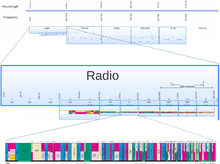
Back تردد مرتفع Arabic HF AST Højfrekvens (3 MHz - 30 MHz) Danish Kurzwelle German Onda corta Spanish Kõrgsagedusala Estonian بسامد بالا Persian HF (taajuusalue) Finnish Haute fréquence French उच्चावृत्ति (HF) Hindi
Frequency range | 3 to 30 MHz |
|---|---|
Wavelength range | 100 to 10 m |
| Radio bands | ||||||||||||
|---|---|---|---|---|---|---|---|---|---|---|---|---|
| ITU | ||||||||||||
|
||||||||||||
| EU / NATO / US ECM | ||||||||||||
| IEEE | ||||||||||||
| Other TV and radio | ||||||||||||

High frequency (HF) is the ITU designation[1] for the band of radio waves with frequency between 3 and 30 megahertz (MHz). It is also known as the decameter band or decameter wave as its wavelengths range from one to ten decameters (ten to one hundred meters). Frequencies immediately below HF are denoted medium frequency (MF), while the next band of higher frequencies is known as the very high frequency (VHF) band. The HF band is a major part of the shortwave band of frequencies, so communication at these frequencies is often called shortwave radio. Because radio waves in this band can be reflected back to Earth by the ionosphere layer in the atmosphere – a method known as "skip" or "skywave" propagation – these frequencies can be used for long-distance communication across intercontinental distances and for mountainous terrains which prevent line-of-sight communications.[2] The band is used by international shortwave broadcasting stations (3.95–25.82 MHz), aviation communication, government time stations, weather stations, amateur radio and citizens band services, among other uses.
- ^ "Rec. ITU-R V.431-7, Nomenclature of the frequency and wavelength bands used in telecommunications" (PDF). ITU. Archived from the original (PDF) on 31 October 2013. Retrieved 28 January 2015.
- ^ Harmon, James V.; Fiedler, Ltc David M; Lam, Ltc Ret John R. (Spring 1994). "Automated HF Communications" (PDF). Army Communicator: 22–26. Archived from the original (PDF) on 23 December 2016. Retrieved 24 December 2018.